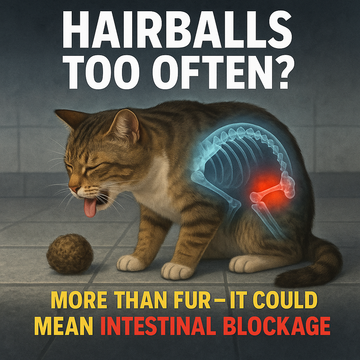Many owners brush off hairballs, saying, “That’s normal, right?” But if your cat coughs up hairballs too often, it’s no longer harmless—it could be an early warning of intestinal blockage or GI disease. Ignoring this can lead to loss of appetite, weight loss, or even life-threatening complications. Are you comforting yourself while missing your cat’s SOS?
1) Why Do Cats Get Hairballs?

-
Self-grooming: Cats swallow loose fur while licking.
-
Normal case: Most fur passes in stool; occasional hairballs are natural.
2) When Is It “Too Often”?

-
More than 2–3 hairballs per month = red flag.
-
Frequent retching without results may mean fur lodged inside.
-
Paired with poor appetite, lethargy, or weight loss, risks are higher.
3) Hidden Health Risks

-
Intestinal blockage: Fur plugs gut → vomiting, constipation, dehydration.
-
Esophagitis/gastritis: Chronic irritation of GI lining.
-
Malnutrition: Frequent vomiting affects nutrient absorption.
4) How to Reduce Hairball Trouble

-
Daily grooming: Especially for long-haired cats, lowers fur intake.
-
Hairball-control diets/pastes: Fiber helps fur move through stool.
-
Cat grass: Stimulates peristalsis, aids passage of fur.
-
Hydration: Enough water reduces blockage risk.
5) When to See the Vet Immediately

-
Repeated retching without producing hairballs.
-
Signs of vomiting, poor appetite, constipation, bloating.
-
Noticeable weight loss or lethargy.
Final Tips
Occasional hairballs are fine, but too frequent is a warning. Stop comforting yourself with “normal”—your cat may be begging for help. Remember: early detection and action = best protection.
We share fresh dog/cat care tips every day—follow us at https://pawcassopet.com/



